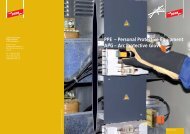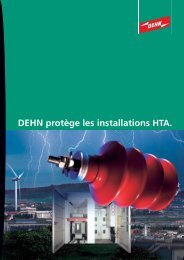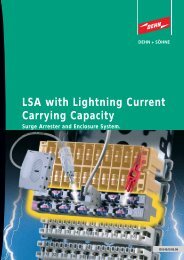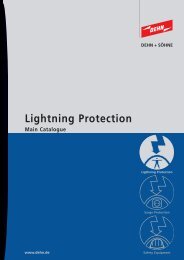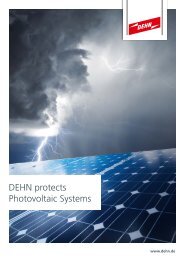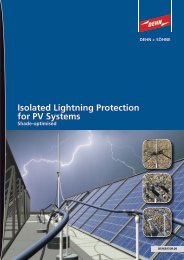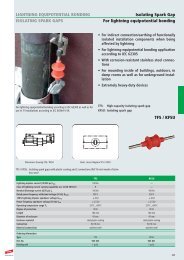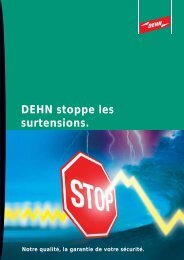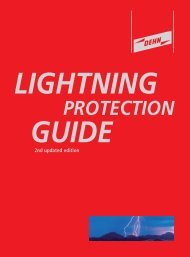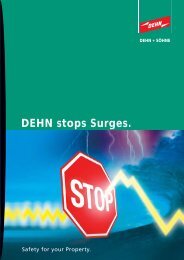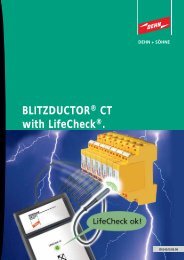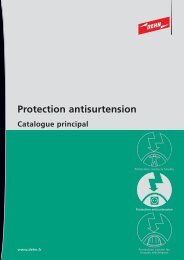You also want an ePaper? Increase the reach of your titles
YUMPU automatically turns print PDFs into web optimized ePapers that Google loves.
DEHN – Safety according to Specification<br />
1<br />
1a<br />
1b<br />
Fig. 3:<br />
Direct/Close lightning strike:<br />
Lightning strike into the external lightning<br />
protection system, process framework<br />
(in industrial installations), cables etc.<br />
Voltage drop at the impulse earthing<br />
resistance R st<br />
Induced voltage in loops<br />
(kA)<br />
i<br />
2c<br />
100 kA<br />
60 kA<br />
50 kA<br />
1a<br />
R st<br />
IT system<br />
1b<br />
1<br />
L1<br />
L2<br />
L3<br />
PEN<br />
low voltage power<br />
supply system<br />
2a<br />
20 kV<br />
Causes of surges in case of lightning discharges<br />
2<br />
20 μs<br />
200 μs<br />
1<br />
350 μs 600 μs 800 μs 1000 μs<br />
t<br />
2a<br />
2b<br />
2c<br />
2b<br />
Distant lightning strike:<br />
Strike into medium voltage<br />
overhead lines<br />
Surge travelling waves on<br />
overhead lines due to<br />
cloud-to-cloud lightning<br />
Fields of the lightning<br />
channel<br />
Wave form [μs] 10/350 8/20<br />
imax [kA] 100 5<br />
Q [As] 50 0.1<br />
W/R [J/Ω] 6 2.5 10 3 0.4 10<br />
Standard IEC 62305-1 EN 6100-4-5<br />
Fig. 4:<br />
1<br />
Test impulse current for<br />
2<br />
Test impulse current for<br />
lightning current arresters surge arresters<br />
(μs)<br />
To ensure permanent availability of complex power supply and<br />
IT systems even in case of a direct lightning effect, further<br />
surge protection measures for electrical and electronic installations<br />
are necessary in addition to the lightning protection system<br />
of a structure. Taking all causes of surges into consideration<br />
is very important. For this purpose, the lightning protection<br />
zones concept described in IEC 62305-4 is applied (Fig. 5).<br />
A structure is subdivided into different risk zones. These zones<br />
help to define the necessary protection measures, in particular<br />
the lightning and surge protection devices and components.<br />
Part of an EMC-conform lightning protection zones concept is<br />
an external lightning protection system (including air-termination<br />
system, down-conductor system, earthing), equipotential<br />
bonding, spatial shielding and surge protection for the power<br />
supply systems and IT systems. The lightning protection zones<br />
have to be defined according to Table 1.<br />
According to the requirements and loads at the place of installation<br />
of surge protective devices, they are classified into lightning<br />
current arresters, surge arresters and combined lightning<br />
current and surge arresters.<br />
The highest discharge capacity requirements are placed on<br />
lightning current arresters and combined lightning current and<br />
surge arresters used at the transition from lightning protection<br />
zone 0 A to 1 or 0 A to 2.<br />
These SPDs must be able to conduct partial lightning currents<br />
(wave form 10/350 μs) several times without destruction in<br />
order to prevent penetration of destructive partial lightning currents<br />
into the electrical installation of a building.<br />
At the transition from LPZ 0 B to 1 or downstream of the lightning<br />
current arrester at the transition from LPZ 1 to 2 and higher,<br />
surge arresters are used for protection against surges. Their<br />
function is to further reduce both the residual loads of the<br />
upstream protection stages and to limit the induced surges or<br />
surges produced in the installation.<br />
air termination system<br />
ventilation<br />
spatial shield<br />
M<br />
terminal device<br />
The lightning and surge protective measures at the lightning<br />
protection zone boundaries described above apply to both<br />
power supply systems and IT systems to the same extent.<br />
All measures described in the EMC-conform lightning protection<br />
zones concept help to achieve permanent system availability<br />
of a modern infrastructure.<br />
downconductor<br />
system<br />
For more detailed technical information, we will be pleased to<br />
send you our “Lightning Protection Guide”.<br />
l.v. power<br />
supply system<br />
IT system<br />
foundation earth electrode<br />
steel reinforcement<br />
Lightning equipotential bonding<br />
Lightning current arrester (SPD Type 1)<br />
Local equipotential bonding<br />
Surge arrester (SPD Type 2, SPD Type 3)<br />
Lightning equipotential bonding<br />
Lightning current arrester<br />
Local equipotential bonding<br />
Surge arrester<br />
Lightning electromagnetic<br />
pulse<br />
Switching electromagnetic<br />
pulse<br />
Lightning<br />
protection zone<br />
Fig. 5:<br />
EMC-based lightning protection zones concept<br />
www.dehn.de<br />
LEMP protection of structures with electrical and electronic systems<br />
according to IEC 62305-4<br />
Lightning Protection Zone Description<br />
LPZ 0 A Threat by direct lightning strokes, impulse currents up to complete lightning currents<br />
and the entire lightning field.<br />
LPZ 0 B Protected against direct lightning strokes. Threat by impulse currents up to partial<br />
lightning currents and the entire lightning field.<br />
LPZ 1<br />
LPZ 2<br />
Impulse currents are further limited by current distribution and SPDs situated at<br />
the zone boundaries. The lightning field is mostly attenuated by spatial shielding.<br />
Impulse currents are further limited by current distribution and SPDs situated at<br />
the zone boundaries. The lightning field is mostly attenuated by spatial shielding.<br />
Table 1: Definition of lightning protection zones (LPZ)<br />
7



